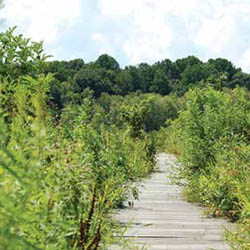 Until a few years ago, most area residents under the age of 50 would have been surprised to learn that the Mentor Marsh was once a lush wetland forest. This rich, unique ecosystem was spoiled in the 1960s when salt tailings were dumped into the eastern end of the basin. As native trees and plants died off, the invasive, salt-tolerant plant, Phragmites australis, began to dominate the landscape.
Until a few years ago, most area residents under the age of 50 would have been surprised to learn that the Mentor Marsh was once a lush wetland forest. This rich, unique ecosystem was spoiled in the 1960s when salt tailings were dumped into the eastern end of the basin. As native trees and plants died off, the invasive, salt-tolerant plant, Phragmites australis, began to dominate the landscape.
Fortunately, the Cleveland Museum of Natural History (CMNH) has been committed to restoring the Mentor Marsh with a coalition of government and agency partners.
Since the 1980s, remediation efforts to reduce salt contamination have been ongoing, and have led to steady improvement of the ecosystem.
For the past decade, the CMNH has been working to restore the Marsh by removing the Phragmites and encouraging native plant growth. Eradication of the Phragmites and re-establishment of native species has set this unique ecosystem on the road to recovery and the results are already apparent.
Birds, fish and other wildlife, including rare specimens such as the American and Least Bitterns, Virginia, King and Sora Rails, have also returned to the area.
And, you can see the results for yourself! Visit the Marsh to observe a wide variety of birds as they stop at to feed and rest on their way to their winter nesting sites. Fall migration begins in late July, but the best month to see migrating songbirds is September.
